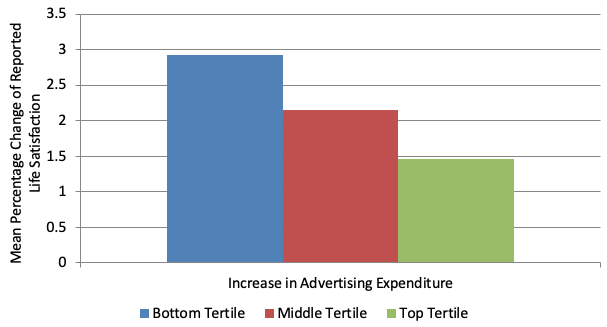Advertising is ubiquitous. In recent decades, the volume of advertising has been growing dramatically. Therefore, it is natural to ask if this harms our wellbeing.
We do not perfectly understand the link between advertising and individual wellbeing. It is reasonable to assume that it might operate through two broad channels that have opposing effects:
- Positive: advertising informs. It may promote human welfare by allowing people to make better choices about products.
- Negative: advertising stimulates desires that are not feasible. This creates dissatisfaction. Hence, advertising might reduce welfare by unduly raising consumption aspirations.
At the national level, we do not know which of the two effects is dominant. Many national variables influence wellbeing, in particular the generosity of the welfare state and variables such as unemployment (DiTella et al. 2001, DiTella et al. 2003, and Radcliff 2013). But recent research on subjective wellbeing, described in sources such as Easterlin (2003), Oswald (1997), Layard (2005) and Clark (2018), has paid little attention to the role of advertising, and so there are no cross-country econometric studies of the effect of advertising using representative samples of adults.
Keeping up with the Joneses
In this context, is a reasonable hypothesis that advertising has a negative effect on wellbeing. Easterlin (1974) found early evidence suggesting that society does not become happier as it grows richer. He suggested that one mechanism might be that individuals compare themselves with their neighbours. Easterlin’s thesis, in part, assumes that we desire conspicuous consumption (Veblen 1899, 1904).
If individuals have ‘relativistic’ preferences, so that they look at others before deciding how satisfied they feel, then when they consume more goods, they fail to become happier because they see others also consuming more. The pleasure of my new car is taken away if Ms Jones, in the parking spot next to mine, has also just bought one. More recent evidence on ‘comparison effects’ has been reviewed by Clark (2018). Mujcic and Oswald (2018) also find longitudinal evidence of negative wellbeing consequences based on envy.
Since Veblen, many researchers have worried about negative effects on wellbeing of advertising. In some cases they have found small-scale evidence (examples include Richins 1995, Easterlin and Crimmins 1991, Bagwell and Bernheim 1996, Sirgy et al. 1998, Dittmar et al. 2014, Frey et al. 2007, and Harris et al. 2009). Research has focused on the likely detrimental effects upon children (Andreyeva et al. 2011, Borzekowski and Robinson 2001, Buijzen and Valkenburg 2003a, Opree et al. 2013, and Buijzen and Valkenburg 2003b), although the most recent work, by Opree et al. (2016), produced inconclusive results.
Evidence of a negative effect
We have found evidence of negative links between national advertising and national wellbeing (Michel et al. 2019). Using longitudinal information on countries, from pooled cross-sectional surveys, we find that rises and falls in advertising are followed, a few years later, by falls and rises in national life-satisfaction, giving an inverse connection between advertising levels and the later wellbeing levels of nations.
We took a sample of slightly over 900,000 randomly sampled European citizens in 27 countries, surveyed annually from 1980 to 2011. Respondents reported their level of life satisfaction and many other aspects of themselves and their lives. We also recorded total advertising expenditure levels.
Figure 1 illustrates the study’s key idea. It divides the data into tertiles and then plots the (uncorrected) relationship between the change in advertising and the change in life satisfaction. The three vertical bars separate the data into countries that had particularly large increases in advertising expenditure, moderate increases, and small increases. Figure 1 shows that the greater the rise in advertising within a nation, the smaller the later improvement in life satisfaction.
Figure 1 The inverse longitudinal relationship between changes in advertising and changes in the life satisfaction of countries, 1980 to 2011
Notes: Based on a sample of approximately 1 million individuals. Based on shorter period if data not available for that country. Bottom Tertile consists of Czech Republic, Germany after 1989, Estonia, Finland, Lithuania, Hungary, Latvia, Poland, Romania, Slovakia. Mean change 2.93. Middle Tertile consists of Bulgaria, Western Germany (before 1989), Denmark, UK, Sweden, Slovenia, Netherlands, Turkey, Spain. Mean Change: 2.15. Top tertile consists of Austria, Belgium, France, Greece, Croatia, Ireland, Italy, Norway, Portugal. Mean change 1.46.
Advertising does not have a spurious association with life satisfaction that is attributable merely to the business cycle. Using standard regression analysis, we were able to show that the negative effect of advertisement on life satisfaction is not due to the correlation of both variables with the GDP. This negative effect is robust to the inclusion of other variables like country and year fixed effects, unemployment, and individual socioeconomic characteristics that are typically included in any happiness equation.
The effect implies that a hypothetical doubling of advertising expenditure would result in a 3% drop in life satisfaction. That is approximately one half the absolute size of the marriage effect on life satisfaction, or approximately one quarter of the absolute size of the effect of being unemployed.
These results are consistent with concerns that were first aired more than a century ago, and regularly since (Veblen 1904 and Robinson 1933, for example). They are consistent with Easterlin (1974, 2003) and Layard (1980). They may also be consistent with ideas about the negative consequences of materialism (Sirgy et al. 2012, Burroughs and Rindfleisch 2002, Speck and Roy 2008, and Snyder and Debono 1985).
Although there is evidence of an inverse longitudinal relationship between national advertising and national dissatisfaction, we still need to uncover the causal mechanism. But this demands investigation, because the size of the estimated effect here is both substantial and statistically well-determined.
References
Andreyeva T, I R Kelly, R Inas, and J L Harris (2011), "Exposure to food advertising on television: Associations with children’s fast food and soft drink consumption and obesity", Economics and Human Biology 9: 221-313.
Bagwell L S and B D Bernheim (1996), "Veblen effects in a theory of conspicuous consumption", American Economic Review 86: 349-373.
Borzekowski D L G and T N Robinson (2001), "The 30-second effect: An experiment revealing the impact of television commercials on food preferences of pre-schoolers", Journal of the American Dietetic Association 101: 42–46.
Buijzen M and P M Valkenburg PM (2003a), "The unintended effects of television advertising: A parent-child survey", Communication Research 30: 483–503.
Buizjen M and P M Valkenburg PM (2003b), "The effects of television advertising on materialism, parent-child conflict, and unhappiness: A review of research", Journal of Applied Developmental Psychology 24: 437-456.
Burroughs J E and A Rindfleisch (2002), "Materialism and well-being: A conflicting values perspective", Journal of Consumer Research 29: 348-370.
Clark A E (2018), "Four decades of the economics of happiness: Where next?", Review of Income and Wealth 64: 245-269.
Di Tella R, R J MacCulloch, and A J Oswald (2001), "Preferences over inflation and unemployment: Evidence from surveys of happiness", American Economic Review 91: 335-341.
Di Tella R, R J MacCulloch, and A J Oswald (2003), "The macroeconomics of happiness", Review of Economics and Statistics 85: 809-827.
Dittmar H, R Bond, M Hurst M, and T Kassar (2014), "The relationship between materialism and personal well-being: A meta-analysis", Journal of Personality and Social Psychology 107: 879-924.
Easterlin R A (1974), Does economic growth improve the human lot? Some empirical evidence, in: P A David and M W Reder (eds.), Nations and households in economic growth: Essays in honor of Moses Abramowitz. Academic Press: 89-125.
Easterlin R A (2003), "Explaining happiness", Proceedings of the National Academy of Sciences of the USA 100: 11176-11183.
Easterlin R A and Crimmins E M (1991), "Private materialism, personal self-fulfillment, family life, and public interest", Public Opinion Quarterly 55: 499-533.
Frey B, C Denesch, and A Stutzer (2007), "Does watching TV makes us happy?", Journal of Economic Psychology 28: 283–313.
Harris J L, J A Bargh, and K D Brownell (2009), "Priming effects of television food advertising on eating behaviour", Health Psychology 28: 404–413.
Layard R (2005), Happiness: Lessons from a new science, Penguin.
Michel C, M Sovinsky, E Proto, A J Oswald (forthcoming), "Advertising as a Major Source of Human Dissatisfaction: Cross-National Evidence on One Million Europeans", to be published in 2019 in a volume in honor of Richard Easterlin.
Opree S J, M Buizjen and E A van Reijmersdal (2016), "The impact of advertising on children’s psychological wellbeing and life satisfaction", European Journal of Marketing 50: 1975-1992.
Oswald A J (1997), "Happiness and economic performance", Economic Journal 107: 1815-1831.
Radcliff B (2013), The political economy of human happiness: How voters’ choices determine the quality of life, Cambridge University Press.
Robinson J (1933), Economics of imperfect competition, Macmillan.
Sirgy M J, D J Lee, R Kosenko, H L Meadow, D Rahtz, M Cicic, G Xi Jin, D Yarsuvat, D L Blenkhorn, and N Wright (1998), Does television viewership play a role in the perception of quality of life? Journal of Advertising 27: 125-142.
Sirgy J M, E Gurel-Atay, D Webb, M Cicic, M Husic, A Ekici, A Herrmann, I Hegazy, D-J Lee, and J S Johar (2012), "Linking advertising, materialism, and life satisfaction", Social Indicators Research 107: 79-101.
Snyder M and K G Debono (1985), "Appeals to image and claims about quality – Understanding the psychology of advertising", Journal of Personality and Social Psychology 49: 586-597.
Speck S K, A Roy (2008), "The interrelationships between television viewing, values and perceived well-being: A global perspective", Journal of International Business Studies 39: 1197-1219.
Veblen T (1899), The Theory of the Leisure Class, Macmillan.
Veblen T (1904), The Theory of Business Enterprise, Charles Scribner’s Sons.








